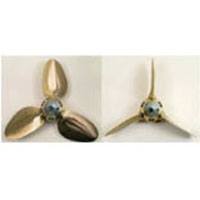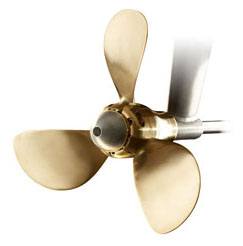Category
Price
Five Reasons You May Need To Change Your Prop
Choosing the wrong Propellers, or continuing to use a Propeller that is damaged, can not only cause your boat to perform poorly, it can increase fuel consumption and even damage your engine and transmission. Here are five conditions that warrant a closer look at your prop.
1. Is your boat slow to come onto plane?
If your propeller has too much pitch (see sidebar), the engine will have a lousy “hole shot” — the ability to get on plane quickly — and will lug. You wouldn’t want to leave from a trafficlight with your car in third gear; not only would it take much longer to accelerate, the engine would be working hard at low speeds, which places a tremendous load on the pistons, crankshaft, and bearings. This in turn can cause detonation, piston seizure, and other engine damage. If your engine can’t get to within 100-200 rpm of rated wide open throttle (WOT), you probably have a prop issue, assuming your engine runs fine and there is not a lot of growth on the hull. Most props can have the pitch adjusted at a prop shop, which can save having to buy a new one. A general rule of thumb is that a one-inch pitch change will result in a 175-225 rpm change at WOT.
2. Does your engine over-rev and the boat seem slow?
If your propeller has too little pitch, the engine can rev past its red-line, which is like driving your car on the interstate in second gear. Continuous running past WOT will soon damage an engine. A prop shop can add more pitch or recommend a new prop. Notice that having either too little or too much pitch can cause engine damage. So why don’t all boats come with the right prop in the first place? They may have but the prop could have been changed later. A boatbuilder doesn’t know how or where you will be using your boat and often uses a compromise prop. Running your boat at high-altitude lakes, for example, requires a different prop than on a boat that will be used at sea level. A boat used to pull skiers or one that is loaded down with weekend gear will require a different prop than a boat used for zooming a couple of fishermen out to a fishing spot.
3. Did you run over a log, hit a sandbar or a rock?
A bent blade or nick will severely affect performance and could even damage the engine and transmission. Note that a bad prop doesn’t always look bad.
Speaking of bent props, what material is best for a prop? A lot depends on where you do your boating. If your chances of hitting a submerged object are low, an aluminum prop is an inexpensive choice. Most manufacturers install aluminum props, but they’re far less rugged than more expensive stainless-steel props.
4. Do you want your boat to be faster?
The first place to look is the prop. As a rule, a stainless-steel prop (assuming the correct pitch and diameter) will make your boat go faster — up to 2-3 knots on some boats. Stainless steel is stronger and can be made thinner, allowing more speed. Stainless steel also flexes less and keeps its shape at higher speeds. The downside to stainless-steel props is cost, about three times more than an aluminum prop, and more expensive repairs. Also, in a severe strike, they may cause drivetrain damage because they won’t deform as easily.
5. Using too much fuel?
It might be your prop. A dinged and bent prop can rob you of 10 percent of your fuel costs. Prop shops can use a machine to tell how far out of specification your prop might be, and repair it like new. They can also advise as to whether you might need a prop of a different diameter. Diameter and pitch are interrelated, and sometimes getting the right prop for the best efficiency is as much art as science and might require trying several different props.
Important Definitions
Diameter
An important factor in thrust — the larger the diameter of the prop, everything else being equal, the more water that gets moved. As a general rule, when performance suffers, you change pitch and not diameter. Diameter is the first number listed in a prop size, such as 14×17.
Pitch and Slippage
Pitch is the distance a prop moves through the water in one revolution. The second number stamped on the prop is pitch. A prop with a pitch of 18 inches would move 18 inches through a solid medium with each complete rotation. The reason a propeller moves something less than 18 inches is because it operates in a liquid medium, which creates slippage. So instead of moving 18 inches, a propeller in water moves maybe 15 inches. Some slippage is essential; without it, the prop can’t move the boat, but too much or too little slippage reduces efficiency.
Rotation
Propellers can rotate to the right (clockwise when viewed from astern) or the left (anticlockwise). Most outboard and I/O propellers rotate to the right. Many sterndrives have two counter-rotating props.
Number of Blades
More blades are smoother but slightly less efficient. The typical compromise is three blades, although four blades are becoming increasingly more popular.
Thickness
Blades should be as thin as possible, since it takes more power to turn a thick blade. Stainless propellers are five times stronger than aluminum, which is why they can be thinner and still retain adequate strength. Hence, stainless-steel props are more efficient.



